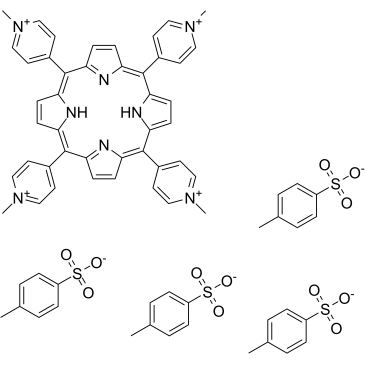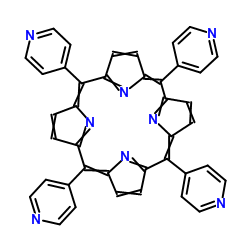36951-72-1
| 中文名 | Α,Β,Γ,Δ-四(1-甲基吡啶嗡-4-基)卟吩对甲苯磺酸盐 |
|---|---|
| 英文名 | meso-tetrakis(N-methyl-4-pyridyl)porphine tetrakis(p-toluenesulfonate) |
| 中文别名 |
5,10,15,20-四-(N-甲基吡啶-4-基)-21H,23H-卟啉-四-(p-甲苯磺酸)
α,β,γ,δ-四(1-甲基吡啶嗡-4-基)卟吩对甲苯磺酸盐 5,10,15,20-四(1-甲基-4-吡啶基)卟啉四(对甲苯磺酸盐) 5,10,15,20-四(N-甲基-4-吡啶鎓)卟吩对甲苯磺酸盐 |
| 英文别名 |
4,4',4'',4'''-(5,10,15,20-Porphyrintetrayl)tetrakis(1-methylpyridinium) tetrakis(4-methylbenzenesulfonate)
TMPyP4 tosylate 4-methylbenzenesulfonate,5,10,15,20-tetrakis(1-methylpyridin-1-ium-4-yl)-21,22-dihydroporphyrin 4,4',4'',4'''-Porphyrin-5,10,15,20-tetrayltetrakis(1-methylpyridinium) tetrakis(4-methylbenzenesulfonate) 5,10,15,20-Tetrakis(N-methyl-4-pyridyl)porphine tetratosylate MFCD00013468 TMPyP ,Mg] [Fo α,β,γ,δ-Tetrakis(1-methylpyridinium-4-yl)porphyrin p-Toluenesulfonate TMPYP tmpyp tetratosylate |
| 描述 | TMPyP4 tosylate (TMP 1363) 是一种四链体 (G-quadruplex) 特异性配体,可抑制 G-四链体和 IGF-1 之间的相互作用。TMPyP4 tosylate (TMP 1363) 是一种端粒酶 (telomerase) 抑制剂,在骨肉瘤细胞系中具有抗肿瘤作用。 |
|---|---|
| 相关类别 | |
| 靶点 |
G-quadruplex[2] Telomerase[2] |
| 参考文献 |
| 分子式 | C72H66N8O12S4 |
|---|---|
| 分子量 | 1363.60 |
| 精确质量 | 1362.368286 |
| PSA | 334.14000 |
| LogP | 10.08380 |
| 外观性状 | 固体;Dark red to Dark purple to Dark blue powder to crystal |
| 储存条件 | 密封、在2 ºC -10 ºC下保存 |
| 稳定性 | 常规情况下不会分解,没有危险反映 |
| 水溶解性 | water: soluble50MM(lit.) |
| 计算化学 | 1.疏水参数计算参考值(XlogP):无 2.氢键供体数量:2 3.氢键受体数量:14 4.可旋转化学键数量:4 5.互变异构体数量:2 6.拓扑分子极性表面积335 7.重原子数量:96 8.表面电荷:0 9.复杂度:1260 10.同位素原子数量:0 11.确定原子立构中心数量:0 12.不确定原子立构中心数量:0 13.确定化学键立构中心数量:0 14.不确定化学键立构中心数量:0 15.共价键单元数量:5 |
| 更多 | 1. 性状: 固体 2. 密度(g/mL,20 ºC):未确定 3. 相对蒸汽密度(g/mL,空气=1): 未确定 4. 熔点(ºC):129-131 5. 沸点(ºC,3mm hg): 256-260 6. 沸点(ºC,5.2kPa):未确定 7. 折射率:未确定 8. 闪点(ºC):未确定 9. 比旋光度(º):未确定 10. 自燃点或引燃温度(ºC): 未确定 11. 蒸气压(kPa,25ºC):未确定 12. 饱和蒸气压(kPa,60ºC): 未确定 13. 燃烧热(KJ/mol):未确定 14. 临界温度(ºC):未确定 15. 临界压力(KPa):未确定 16. 油水(辛醇/水)分配系数的对数值:未确定 17. 爆炸上限(%,V/V):未确定 18. 爆炸下限(%,V/V):未确定 19. 溶解性:未确定 |
|
Section I.Chemical Product and Company Identification Chemical NameTMPyP [=Tetrakis(1-Methylpyridinium-4-yl)porphine p-Toluenesulfonate] [Ultra-high sensitive spectrophotometric reagent for Cu, Mg, and use for the simultaneous determination of metals by HPLC.] Portland OR SynonymNot available.
C72H66N8O12S4 Chemical Formula CAS Number36951-72-1 Section II.Composition and Information on Ingredients Chemical NameCAS Number Percent (%)TLV/PELToxicology Data TMPyP [=Tetrakis(1-Methylpyridinium-4-yl)porphine36951-72-1-------------- Not available.Not available. p-Toluenesulfonate] [Ultra-high sensitive spectrophotometric reagent for Cu, Mg, and use for the simultaneous determination of metals by HPLC.] Section III. Hazards Identification Acute Health EffectsIrritating to eyes and skin on contact. Inhalation causes irritation of the lungs and respiratory system. Inflammation of the eye is characterized by redness, watering, and itching. Skin inflammation is characterized by itching, scaling, reddening, or, occasionally, blistering. Follow safe industrial hygiene practices and always wear proper protective equipment when handling this compound. Chronic Health EffectsCARCINOGENIC EFFECTS : Not available. MUTAGENIC EFFECTS : Not available. TERATOGENIC EFFECTS : Not available. DEVELOPMENTAL TOXICITY: Not available. There is no known effect from chronic exposure to this product. Repeated or prolonged exposure to this compound is not known to aggravate existing medical conditions. Section IV.First Aid Measures Eye ContactCheck for and remove any contact lenses. DO NOT use an eye ointment. Flush eyes with running water for a minimum of 15 minutes, occasionally lifting the upper and lower eyelids. Seek medical attention. Treat symptomatically and supportively. Skin ContactAfter contact with skin, wash immediately with plenty of water. Gently and thoroughly wash the contaminated skin with running water and non-abrasive soap. Be particularly careful to clean folds, crevices, creases and groin. Cover the irritated skin with an emollient. Seek medical attention. Treat symptomatically and supportively. Wash any contaminated clothing before reusing. InhalationIf the victim is not breathing, perform artificial respiration. Loosen tight clothing such as a collar, tie, belt or waistband. If breathing is difficult, oxygen can be administered. Seek medical attention. Treat symptomatically and supportively. IngestionINDUCE VOMITING by sticking finger in throat. Lower the head so that the vomit will not reenter the mouth and throat. Loosen tight clothing such as a collar, tie, belt, or waistband. If the victim is not breathing, administer artificial respiration. Examine the lips and mouth to ascertain whether the tissues are damaged, a possible indication that the toxic material was ingested; the absence of such signs, however, is not conclusive. Seek immediate medical attention and, if possible, show the chemical label. Treat symptomatically and supportively. Section V.Fire and Explosion Data Not available. Combustible.Auto-Ignition Flammability Flammable Limits Flash PointsNot available. Not available. Combustion ProductsThese products are toxic carbon oxides (CO, CO 2), nitrogen oxides (NO, NO2), sulfur oxides (SO2, SO3...). Fire Hazards No specific information is available regarding the flammability of this compound in the presence of various materials. Continued on Next Page a5oppTMPyP [=Tetrakis(1-Methylpyridinium-4-yl)porphine p-Toluenesulfonate] [Ultra-high sensitive spectrophotometric reagent for Cu, Mg, and use for the simultaneous determination of metals by HPLC.] Explosion HazardsRisks of explosion of the product in presence of mechanical impact: Not available. Risks of explosion of the product in presence of static discharge: Not available. No additional information is available regarding the risks of explosion. Fire Fighting Media SMALL FIRE: Use DRY chemicals, CO 2, water spray or foam. and InstructionsLARGE FIRE: Use water spray, fog or foam. DO NOT use water jet. Section VI.Accidental Release Measures Spill CleanupIrritating material. InstructionsIn case of a spill and/or a leak, always shut off any sources of ignition, ventilate the area, and exercise caution. Use a shovel to put the material into a convenient waste disposal container. Finish cleaning the spill by rinsing any contaminated surfaces with copious amounts of water. Consult federal, state, and/or local authorities for assistance on disposal. Section VII. Handling and Storage IRRITANT. HYGROSCOPIC. Keep away from heat and sources of ignition. Mechanical exhaust required. When not in Handling and Storage use, tightly seal the container and store in a dry, cool place. Avoid excessive heat and light. DO NOT ingest. DO NOT Information breathe dust. In case of insufficient ventilation, wear suitable respiratory equipment. If ingested, seek medical advice immediately and show the container or the label. Treat symptomatically and supportively. Avoid contact with skin and eyes. Always store away from incompatible compounds such as oxidizing agents, moisture. Section VIII. Exposure Controls/Personal Protection Engineering ControlsUse process enclosures, local exhaust ventilation, or other engineering controls to keep airborne levels below recommended exposure limits. If user operations generate dust, fume or mist, use ventilation to keep exposure to airborne contaminants below the exposure limit. Splash goggles. Lab coat. Dust respirator. Boots. Gloves. A MSHA/NIOSH approved respirator must be used to avoid Personal Protection inhalation of the product. Suggested protective clothing might not be sufficient; consult a specialist BEFORE handling this product. Exposure Limits Not available. Section IX. Physical and Chemical Properties Physical state @ 20°CPurple powder.Solubility Not available. Not available. Specific Gravity Molecular WeightPartition Coefficient 1363.63Not available. Boiling PointVapor Pressure Not available.Not available. Melting PointNot available.Vapor DensityNot available. Refractive IndexNot available.VolatilityNot available. Critical TemperatureNot available.OdorNot available. ViscosityNot available.TasteNot available. Section X.Stability and Reactivity Data Stability This material is stable if stored under proper conditions. (See Section VII for instructions) Conditions of InstabilityHygroscopic; keep container tightly closed. Avoid excessive heat and light. Incompatibilities Reactive with oxidizing agents, moisture. Section XI. Toxicological Information RTECS NumberNot available. Eye contact. Inhalation. Ingestion. Skin contact. Routes of Exposure Toxicity DataNot available. CARCINOGENIC EFFECTS : Not available. Chronic Toxic Effects MUTAGENIC EFFECTS : Not available. TERATOGENIC EFFECTS : Not available. DEVELOPMENTAL TOXICITY: Not available. There is no known effect from chronic exposure to this product. Repeated or prolonged exposure to this compound is not known to aggravate existing medical conditions. Continued on Next Page TMPyP [=Tetrakis(1-Methylpyridinium-4-yl)porphine p-Toluenesulfonate] [Ultra-high sensitive spectrophotometric reagent for Cu, Mg, and use for the simultaneous determination of metals by HPLC.] Acute Toxic EffectsIrritating to eyes and skin on contact. Inhalation causes irritation of the lungs and respiratory system. Inflammation of the eye is characterized by redness, watering, and itching. Skin inflammation is characterized by itching, scaling, reddening, or, occasionally, blistering. Follow safe industrial hygiene practices and always wear proper protective equipment when handling this compound. Section XII.Ecological Information EcotoxicityNot available. Environmental FateNot available. Section XIII. Disposal Considerations Waste DisposalRecycle to process, if possible. Consult your local or regional authorities. You may be able to dissolve or mix material with a combustible solvent and burn in a chemical incinerator equipped with an afterburner and scrubber system. Observe all federal, state, and local regulations when disposing of this substance. Section XIV. Transport Information DOT Classification Not a DOT controlled material (United States). PIN NumberNot applicable. Proper Shipping NameNot applicable. Packing Group (PG)Not applicable. DOT Pictograms Section XV. Other Regulatory Information and Pictograms TSCA Chemical InventoryThis product is NOT on the EPA Toxic Substances Control Act (TSCA) inventory. The following notices are required by 40 CFR 720.36 (C) for those products not on the inventory list: (EPA) (i) These products are supplied solely for use in research and development by or under the supervision of a technically qualified individual as defined in 40 CFR 720.0 et sec. (ii) The health risks of these products have not been fully determined. Any information that is or becomes available will be supplied on an MSDS sheet. WHMIS Classification WHMIS CLASS D-2A: Material causing other toxic effects (VERY TOXIC). (Canada) EINECS Number (EEC) Not available. EEC Risk StatementsR36/37/38- Irritating to eyes, respiratory system and skin. SECTION 16 - ADDITIONAL INFORMATION N/A |
|
生态学数据: 对水是稍微有危害的不要让未稀释或大量的产品接触地下水、水道或者污水系统,若无政府许可,勿将材料排入周围环境
|
| 符号 |

GHS07 |
|---|---|
| 信号词 | Warning |
| 危害声明 | H315-H319-H335 |
| 警示性声明 | P261-P305 + P351 + P338 |
| 个人防护装备 | dust mask type N95 (US);Eyeshields;Gloves |
| 危害码 (欧洲) | Xi: Irritant; |
| 风险声明 (欧洲) | R36/37/38 |
| 安全声明 (欧洲) | 26-36/37 |
| 危险品运输编码 | NONH for all modes of transport |
| WGK德国 | 3 |
|
~36% 
36951-72-1 |
| 文献:Bonnet, Raymond; Ridge, R. J.; Land, Edward J.; Sinclair, Roy S.; Tait, David; Truscott, T. George Journal of the Chemical Society, Faraday Transactions 1: Physical Chemistry in Condensed Phases, 1982 , vol. 78, p. 127 - 136 |



